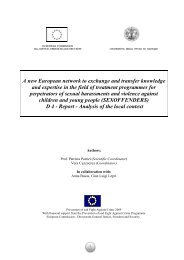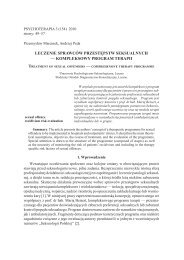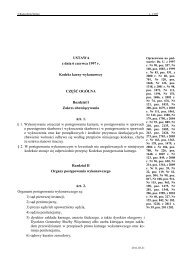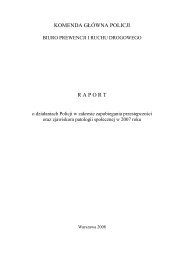ENGLISH
ENGLISH
ENGLISH
- No tags were found...
Create successful ePaper yourself
Turn your PDF publications into a flip-book with our unique Google optimized e-Paper software.
MAPPING RESULTS – ITALYGeneral InformationItaly has 60 million inhabitants. As of 31 December 2009, the female population was around 31 million and the male populationaround 29 million.Italy is divided into 20 regions. The capital town is Rome; other big cities are Milan and Turin in the North, Naples and Palermoin the South of Italy.The Emilia-Romagna RegionThe Emilia-Romagna Region, situated between the north and the centre of Italy, is one of the best developed regions, with agood welfare level (regarding health care, education, social services, housing, employment, equal opportunities for women,etc.). It has 4 395 606 inhabitants: 2.259.640 women and 2 135 966 men. The chief town is Bologna. In the east of the region,about 70 km from Bologna, there is the town of Ravenna, with 135 000 inhabitants.The Region Emilia-Romagna (along with Lombardy and Tuscany) is one of the Italian regions with the largest number of antiviolencecentres. It has 12 independent Anti-Violence Centres (about one per Province), plus a Municipal Women’s Centre inForlì town. Most of them have been established since the 1990s, and 10 independent centres are associated in the network‘Coordinamento dei centri antiviolenza dell’Emilia-Romagna‘, that has a good cooperation with the administration of theEmilia-Romagna Region (for instance, a joint periodical research on women seeking help to anti-violence centres). The Istatresearch on violence against women comes to the conclusion that the region has the highest rate of physical and/or sexualviolence in Italy: 38.2% as opposed to 31.9% on the national level.In Italy it is almost impossible to provide annual data about domestic violence on the national level (only one research donein 2006), and consequently about high risk victims, because there is no national observatory on gender-based violence andno National Action Plan. At present the Italian Minister of Gender Policy, Mara Carfagna, is working on a proposal for anItalian NAP, but it hasn’t been approved yet. The same situation characterises the research about data on homicides andattempted homicides in the family, since the Minister of the Interior does not provide specific data that could allow the analysisof the relationship between victim and perpetrator. Data are available only from Eures Institute of Research that collectsthem via Ansa Press Agency (Eures-Ansa, L’omicidio volontario in Italia. Rapporto Eures-Ansa 2009, Roma 2009: last dataavailable for 2008). The same difficulty exists also on the regional and provincial levels. The only epidemiological research thatconsiders the national level for gender violence was published in 2007 by the Istat (National Institute of Statistic): La violenza e imaltrattamenti contro le donne dentro e fuori la famiglia. Anno 2006. Here it is possible to find data about rape reports, domesticviolence, harassments and stalking, but there are no reported homicides and attempted homicides. Moreover, it must beconsidered that in Italy the power of the police to arrest people is generally limited to serious injuries or flagrant crimes, andother instruments to restrain the perpetrators are lacking.The 10 AVC of the network in Emilia-Romagna provide totally 109 bed places (for women and children both), corresponding toabout 36 family places (3 beds each). According to European standards, anti-violence centres should have about 586 familyplaces in the shelters of the region, which means that only 6% of the required places are covered. Thus, it is evident that theprotection of women is widely insufficient in the region.Since 2003 the Emilia-Romagna Region mentions violence against women in its welfare law (Regional Law n. 2/2003),suggesting to local administrations to take care of this problem inside the local integrated social services system, through antiviolencecentres and shelters, even if there isn’t a formal commitment to do so by law. Every district has its own character-P 43






